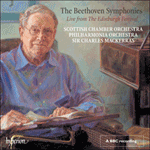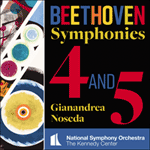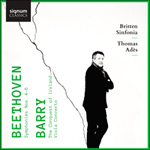
Welcome to Hyperion Records, a British classical label devoted to presenting high-quality recordings of music of all styles and from all periods from the twelfth century to the twenty-first.
Hyperion offers both CDs, and downloads in a number of formats. The site is also available in several languages.
Please use the dropdown buttons to set your preferred options, or use the checkbox to accept the defaults.

The symphony’s slow introduction is set mostly in the minor. This mysterious Adagio, which only gradually gropes its way towards the light, gives no hint of the brilliance of the music to come, though its halting, detached violin notes may be heard as a version in slow-motion of the Allegro vivace’s main theme. As so often in Beethoven, the most spellbinding moment occurs in the very long and subdued preparation for the onset of the recapitulation. Here, the orchestra is reduced to the violins on their own, giving out the ‘rocking’ figure from the movement’s main subject over and again, in overlapping phrases that leave the music hovering on the brink of a distant key. In a still more mysterious moment the first violins reiterate the rushing scale figure that had first appeared during the transition from the slow introduction to the Allegro vivace, while muffled drum-rolls add atmosphere to the proceedings. The inclusion of the timpani at this moment, with the music still in a remote key, is a highly original stroke. Until the twentieth century, when a mechanism for controlling the tension of the membrane by means of a pedal was introduced, the use of timpani was largely limited to sections of the music set in, or near, the home key. Beethoven, however, overcomes this limitation by treating the fundamental note B flat—the note to which one of his two timpani has been tuned from the outset—as its enharmonic aural equivalent, A sharp. The passage in question is one whose tonality is veiled and ambiguous, and the mysterious timpani rolls find the music poised on the brink of the key of B major. Following this moment, there is a luminous sea-change back into the home key, and a B flat timpani roll underpins the whole of the long crescendo that catapults the start of the recapitulation.
The slow movement is based on one of Beethoven’s favourite types of juxtaposition: a broad, sustained melody unfolding over an accompaniment in a sharply defined, military-style rhythm. The rhythm ceases for the main theme’s luxuriant continuation, with sonorous arpeggios on the strings, as well as for a deeply expressive clarinet melody delicately accompanied by both arco and pizzicato strings; but it returns in the closing bars, where the spotlight again falls on the timpani, which give the rhythm out on their own.
As Beethoven’s symphonic designs grew broader, he clearly felt the need to expand the scope of the scherzo to match that of the surrounding movements. His solution was transform what had traditionally been a tripartite form into a five-part design in which the trio was played twice, between three appearances of the scherzo. In the fourth symphony the design is actually abridged, with the second appearance of the slower trio followed only by a portion of the scherzo’s second half. Both the jagged arpeggio-like shape of the scherzo’s syncopated theme, and the notion of casting the trio as a slower piece predominantly scored for the winds, anticipate the character of the corresponding movement in the seventh symphony.
The bubbling finale is a piece imbued with the spirit of Haydn. A particularly felicitous touch is the ‘running’ bassoon solo which inaugurates the recapitulation, with the explosive orchestral chords of the movement’s opening bars replaced by gentle pizzicatos. The moment is brief, but the bassoon writing is notoriously tricky. In the closing bars Beethoven takes a further leaf out of Haydn’s book by allowing the music to degenerate into pure farce, with fragments of the main theme limply played at half speed, as if the piece were about to collapse altogether, before an abrupt gesture from the full orchestra brings the curtain down.
from notes by Misha Donat © 2007
L’introduction lente de cette Symphonie no 4 est, pour l’essentiel, en mineur. Ce mystérieux Adagio, qui n’avance qu’à petits pas vers la lumière, ne laisse rien présager de l’éclat à venir, quoique ses notes de violon heurtées, détachées, puissent être perçues comme une version au ralenti du thème principal de l’Allegro vivace. Comme si souvent chez Beethoven, le moment le plus ensorcelant correspond à une préparation fort longue, et fort sobre, du début de la réexposition. Ici, l’orchestre est réduit aux seuls violons, qui exposent encore et encore la figure «berçante» du sujet principal du mouvement dans des phrases chevauchantes laissant la musique suspendue au bord d’une tonalité lointaine. Dans un passage plus sibyllin encore, les premiers violons réitèrent la figure en gamme précipitée apparue pour la première fois pendant la transition entre l’introduction lente et l’Allegro vivace, cependant que des roulements de tambour étouffés installent une certaine atmosphère. L’inclusion de timbales à ce moment précis, alors que la musique est toujours dans un ton éloigné, est des plus originales. Avant le Xxe siècle et l’introduction d’une pédale visant à contrôler la tension de la membrane, l’usage des timables était largement limité aux sections écrites dans la tonalité principale ou, du moins, non loin d’elle. Beethoven, toutefois, surmonte cette restriction en traitant la fondamentale si bémol—la note sur laquelle une de ses deux timbales a été accordée dès le début—comme son équivalent enharmonique sur le plan sonore, la dièse. Ce passage voit sa tonalité voilée et ambiguë, et les énigmatiques roulements de tambour trouvent la musique en équilibre au bord du ton de si majeur. Cet instant précède un changement radical et lumineux qui nous ramène dans la tonalité principale, un paisible roulement de timbale en si bémol sous-tendant le long crescendo qui catapulte le commencement de la réexposition.
Le mouvement lent repose sur l’une des juxtapositions préférées de Beethoven: une ample mélodie tenue qui s’éploie sur un accompagnement au rythme militaire, bien défini. Interrompu par la poursuite luxuriante du thème principal, avec de retentissants arpèges aux cordes, et par une mélodie de clarinette profondément expressive (accompagnée des cordes jouant arco et en pizzicato), ce rythme revient dans les mesures conclusives, où les projecteurs sont de nouveau braqués sur les timbales, qui le donnent seules.
À mesure que ses conceptions symphoniques s’élargirent, Beethoven éprouva visiblement le besoin d’étoffer le scherzo jusqu’à lui faire atteindre l’envergure des mouvements environnants. Pour y parvenir, il transforma la traditionnelle forme à trois parties en un modèle à cinq parties où le trio était joué deux fois, entre trois apparitions du scherzo. Mais, ici, ce schéma est abrégé, la seconde énonciation du trio ralenti n’étant suivi que d’un fragment de la seconde moitié du scherzo. Et la forme déchiquetée, à la manière d’arpèges, du thème syncopé du scherzo, et l’idée de couler le trio en un ralenti écrit pour une prédominance de cordes anticipent le caractère de ce même mouvement dans la septième symphonie.
Le bouillonnant finale est imprégné d’esprit haydnien. Moment particulièrement réussi: le solo de basson «allant» qui inaugure la réexposition, avec les explosifs accords orchestraux des premières mesures du mouvement remplacées par de doux pizzicati. Cela dure peu, mais l’écriture de basson est d’une difficulté notoire. Dans les mesures conclusives, Beethoven arrache un nouveau feuillet au manuel de Haydn et laisse la musique dégénérer en pure farce: des fragments du thème principal sont mollement joués à mi-tempo, comme si la pièce allait complètement s’effondrer, avant qu’un geste brusque, au grand orchestre, ne fasse tomber le rideau.
extrait des notes rédigées par Misha Donat © 2007
Français: Hypérion
Die langsame Einleitung der Sinfonie ist fast durchgängig in Moll gehalten. Dieses mysteriöse Adagio, das sich nur allmählich ans Licht vortastet, lässt nichts von der kommenden brillanten Musik ahnen, auch wenn man die zögernden, abgesetzten Violinnoten als eine Zeitlupenversion des Hauptthemas aus dem Allegro vivace hören könnte. Wie so häufig bei Beethoven geschieht der zauberhafteste Moment in der sehr langen und gedämpften Vorbereitung für den Einsatz der Reprise. Hier ist das Orchester auf Violinen reduziert, die immer wieder die „sich hin und her wiegende“ Geste aus dem Hauptthema des Satzes bringen, und zwar in Form von sich überschneidenden Phrasen, die der Musik den Eindruck verleihen, als stünde sie zögernd an der Schwelle zu einer entfernt liegenden Tonart. In einem noch mysteriöseren Moment wiederholen die ersten Violinen die Geste mit virtuosem Laufwerk, die zuerst in der Überleitung von der langsamen Einleitung zum Allegro vivace aufgetaucht war, während gedämpfte Paukenwirbel für eine spezielle Atmosphäre sorgen. Die Verwendung der Pauken in einem Moment, wo die Musik noch immer in einer entfernten Tonart steht, ist ein äußerst origineller Einfall. Bis zum 20. Jahrhundert (wo man einen Mechanismus zur Kontrolle der Fellspannung vermittels eines Pedals erfand) war der Einsatz der Pauken im Großen und Ganzen auf Musikabschnitte beschränkt, die in der Grundtonart oder zumindest in der Nähe davon standen. Beethoven löste dieses Problem hier, indem er den Grundton B—eine Note, auf die eine seiner beiden Pauken von Anfang an gestimmt war—einer enharmonischen Umdeutung unterzog, also als Ais las. In eben jener Passage ist die Tonalität verschleiert und mehrdeutig, und bei den mysteriösen Paukenwirbeln steht die Musik auf der Schwelle zur Tonart H-Dur. Nach diesem Moment gibt es eine spektakuläre Rückwendung zur Grundtonart, und ein leiser Paukenwirbel auf B liegt dem gesamten langen Crescendo zugrunde, das die Reprise anspringen lässt.
Der langsame Satz liefert ein Beispiel für eine von Beethovens beliebtesten Schichtungsverfahren: eine breite, ausgedehnte Melodie entfaltet sich über einer Begleitung aus klar definierten marschartigen Rhythmen. Der Rhythmus schweigt für die von klangvollen Streicherarppegios durchzogene, strahlende Weiterführung des Hauptthemas sowie für eine tief empfindsame Klarinettenmelodie, die zart von sowohl arco als auch pizzicato spielenden Streichern begleitet wird. In den letzten Takten kehrt dieser Rhythmus aber wieder zurück, wo auch die Pauken erneut ins Rampenlicht treten und den Rhythmus allein schlagen.
Als Beethovens sinfonische Formen wuchsen, empfand der Komponist offensichtlich das Bedürfnis, auch die Ausmaße des Scherzos zu erweitern, damit kein Ungleichgewicht zu den anderen Sätzen entsteht. Seine Lösung bestand in der Umformung der traditionell dreiteiligen zu einer fünfteiligen Form, wobei das Trio zweimal, d. h. zwischen den drei A-Teilen, gespielt wurde. In der 4. Sinfonie ist dieses Modell eigentlich gekürzt, d. h. nach dem zweiten Durchgang des im Vergleich zum A-Teil langsameren Trios folgt nur ein Teil der zweiten A-Hälfte. Sowohl die zerklüftete, arpeggioartige Gestalt des synkopierten Scherzothemas wie auch die Entscheidung für ein langsameres Trio für hauptsächlich Holzbläser nehmen den Charakter des entsprechenden Satzes aus der 7. Sinfonie vorweg.
Der spritzige Schlusssatz ist ein vom Geiste Haydns erfülltes Stück. Eine besonders geglückte Wendung ist das „laufende“ Fagottsolo, das die Reprise einleitet, in der die hereinstürzenden Orchesterakkorde aus den ersten Takten des Satzes durch sanfte Pizzikati ersetzt wurden. Der Satz ist kurz, die Fagottstimme aber offenkundig schwierig. In den abschließenden Takten nimmt Beethoven wieder bei Haydn Unterricht und lässt die Musik zur reinen Farce verkommen, wobei Fragmente des Hauptthemas lustlos und im halben Tempo gespielt werden, als stünde das Stück vor einem völligen Zusammenbruch. Dann lässt eine abrupte Geste des gesamten Orchesters den Vorhang fallen.
aus dem Begleittext von Misha Donat © 2007
Deutsch: Elke Hockings
 Beethoven: Symphonies Beethoven: Symphonies‘Hyperion's set is that early evening Beethoven cycle caught in recordings of remarkable intimacy and focus … it is a set I would happily put int ... ‘So magnificently exhilharating an account’ (BBC Music Magazine)» More |
 Beethoven: Symphonies Nos 4 & 5 Beethoven: Symphonies Nos 4 & 5Two symphonies from Beethoven's so-called 'Heroic' period—No 4 completed in 1806 and the supremely defiant No 5 begun in the same year and completed two years later.» More |
 Beethoven: Symphonies Nos 4, 5 & 6 Beethoven: Symphonies Nos 4, 5 & 6Impeccable performances of Beethoven's middle three symphonies are here presented alongside Gerald Barry's enterprising viola concerto (with soloist Lawrence Power) and the extreme cantata 'The Conquest of Ireland' (bass Joshua Bloom and a text by ...» More |

